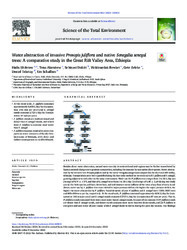Water abstraction of invasive Prosopis juliflora and native Senegalia senegal trees: A comparative study in the Great Rift Valley Area, Ethiopia
Date
2023Author
Hailu, Shiferaw
Tena, Alamirew,
Dzikiti, Sebinasi
Bewket, Woldeamlak
Zeleke, Gete
Teketay, Demel
Schaffner, Urs
Metadata
Show full item recordAbstract
Besides direct water abstraction, natural water scarcity in semi-arid and arid regions may be further exacerbated by human-assisted changes in vegetation composition, including the invasion by non-native plant species. Water abstraction by the invasive tree Prosopis juliflora and by the native Senegalia senegal was compared in the dry Great Rift Valley, Ethiopia. Transpiration rates were quantified using the heat ratio method on six trees each of P. julifora and S. senegal, growing adjacent to each other in the same environment. Water use for P. juliflora trees ranges from 1 to 26 L/day (an average of 4.74 ± 1.97), and that of S. senegal trees from 1 to 38 L/day (an average of 5.48 ± 5.29 during two study years). For both species, soil heat, latent heat, and soil moisture status influenced the rates of sap flow of trees; in addition, water use by P. juliflora trees was related to vapor pressure deficit; the higher the vapor pressure deficit, the higher the water abstraction by P. juliflora. Stand densities of pure P. juliflora and S. senegal were 1200–1600 trees and 400–600 trees per ha, respectively. At the stand scale, P. juliflora consumed approximately 6636 L/day/ha (transpiration: 242 mm per year) and S. senegal stands consumed 2723 L/day/ha (transpiration: 87 mm per year). That is, P. juliflora stands consumed three times more water than S. senegal stands, because of two reasons: (1) P. juliflora stands are denser than S. senegal stands, and denser stands consume more water than less dense stands, and (2) P. juliflora is evergreen and uses water all year-round, while S. senegal sheds its leaves during the peak dry seasons. Our findings suggest that, compared to S. senegal, P. juliflora invasion results in severe impacts on groundwater resources of the drylands of Ethiopia, with direct and indirect consequences to ecosystem services and rural livelihoods.
URI
https://www.sciencedirect.com/science/article/pii/S0048969722079360https://hdl.handle.net/13049/664
Collections
- Research articles [88]

